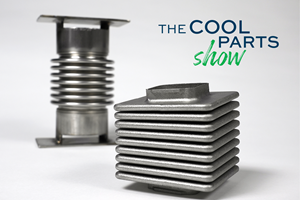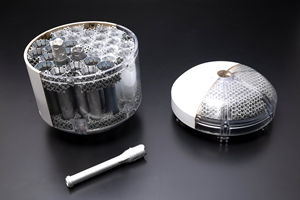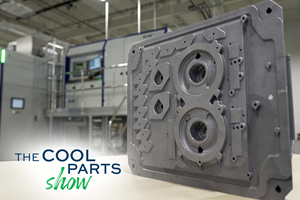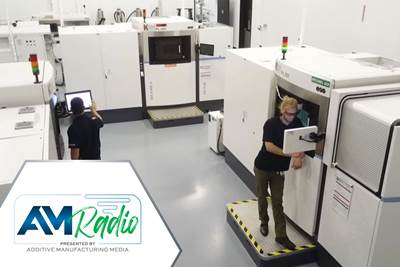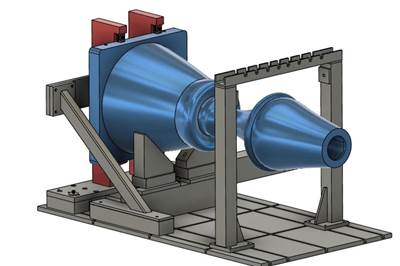As laser powder bed fusion (LPBF) machines get larger, they introduce new challenges when it comes to the ergonomics and economics of 3D printing metal parts from powder. Scaling up means adopting more equipment into the AM workflow for safe handling of parts, build plates and materials; simultaneously, the value of machine time and cost of parts can shift. This video filmed at CIMP-3D, the Center for Innovative Materials Processing through Direct Digital Deposition located at Penn State University, looks at a large-format “factory” built around a 3D Systems DMP500 3D printer with a build area measuring 500 × 500 mm.
To deal with the heavy build plates, large amounts of powder and big parts produced, this machine is surrounded by a collection of peripherals. This equipment includes a Build Breakout Station, Powder Recycling Module, specialized wire EDM, and a transportation module to move material and builds ergonomically. While this machine can be applied to make very large parts, its more economical application might be to produce multiple smaller parts at once.
Transcript
Laser powder bed fusion is getting larger, but working with a large format 3D printer requires some unique considerations with regards to ergonomics and economics.
I'm Stephanie Hendrixson here at CIMP3D. This is Penn State's Center for Innovative Materials Processing through Direct Digital Deposition. One of the pieces of equipment that they use here is this DMP 500 from 3D Systems.
This is a large format 3D printer with a build plate that measures 500 by 500 millimeters.
can make really large parts in builds that take hours up to days. But to really make use of this system required a whole suite of auxiliary equipment. Basically, you have to build a large-format factory around this printer.
In the case of this DMP 500, the core of the whole system is the Removable Powder Module, the RPM. This is a removable unit that contains the build plate and all of the material needed for a given print. Before the build starts, the RPM is installed into the printer. It has to be moved using a transportation module that has been specifically designed by 3D systems for use with this machine.
Once the build is complete, the entire RPM is removed to the Build Breakout station. There are glove boxes on either side of this unit that allow two different operators to be depowdering at the same time. There's also an arm inside that can lift the build plate, tilt it and vibrate it to get all of the excess material out.
From there the RPM with all of that excess material is going to the Powder Recycling Module. That's where the material is going to be filtered and prepared for reuse.
Meanwhile, the build plate with all of the parts is going to this wire EDM that was developed by GF in collaboration with 3D Systems, specifically for 3D printed part cut-off.
So you need all of these different peripherals in order to make this system work because of the ergonomics. It would just be difficult to deal with parts and build plates and equipment of this scale. The build plates alone can be so heavy that you need two operators to move them, if you want to move them that way at all. You're dealing with a lot of powder, maybe 200 kilograms or more per build, and the parts that are made in this machine tend to be heavy and awkward to manage. And so all of these additional pieces of automation and ergonomic equipment are necessary for this to work.
So where does a large format, large frame printer like this make sense? The obvious answer is for making really big parts, especially when you're thinking about things like casting replacements. But there are also other reasons to choose a large format 3D printer. If you think about it, the build plate inside of this machine could potentially take the place of four smaller build plates that would be found inside of a smaller mid-frame machine, and so you might be able to print four or more parts all at once that would take multiple pieces of equipment otherwise. So you're getting the same number of parts in the same amount of time just with one machine, so it could be the more economical choice as well.
Related Content
Variable Resistance Valve Trim Achieves Lead Time Reduction Through AM: The Cool Parts Show #69
Baker Hughes is realizing shorter lead times and simplified manufacturing through powder bed fusion to produce valve trims previously assembled from many machined metal parts.
Read MoreFlexible Bellows Made Through Metal 3D Printing: The Cool Parts Show #64
Can laser powder bed fusion create metal parts with controlled flexibility? We explore an example in this episode of The Cool Parts Show.
Read More3D Printed Lattice for Mars Sample Return Crash Landing: The Cool Parts Show Bonus
NASA Jet Propulsion Laboratory employs laser powder bed fusion additive manufacturing plus chemical etching to create strong, lightweight lattice structures optimized to protect rock samples from Mars during their violent arrival on earth.
Read More3D Printed Brake Panel for the Rail Industry: The Cool Parts Show #52
In this episode of The Cool Parts Show, laser powder bed fusion simplifies the manufacturing of air brake panels for light rail systems made by Wabtec.
Read MoreRead Next
How to Organize for Additive Production: AM Radio #42
Tim Simpson and Peter Zelinski discuss the next steps for succeeding with AM: After technical and process successes come the cultural, organizational and even costing considerations associated with this mode of manufacturing.
Read MorePart Removal Efficiency In a 600 mm Plus World
Clay Olson of EDM Performance Accessories discusses the difficulties and opportunities in cutting off parts from the build plates of large AM systems. Molybdenum wire EDM offers an effective solution to the challenge of large-part cutoff.
Read More4 Ways the Education and Training Challenge Is Different for Additive Manufacturing
The advance of additive manufacturing means we need more professionals educated in AM technology.
Read More

.jpg;width=70;height=70;mode=crop)
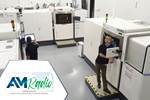






.png;maxWidth=300;quality=90)








